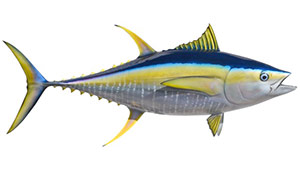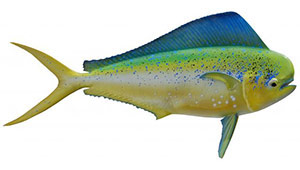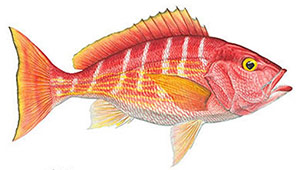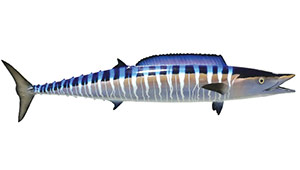Dana’s Tuna Frenzy Tournament Rules
- Registration Fee: The cost is $1,200 paid via PayPal, check, or cash. All sales are final. All registrations need to be submitted by July 7th, 2023. Anything submitted after that will be considered late.
- Late Registration: The total including the late fee is $1,400 paid via PayPal. Late registration will be accepted until the day before, Friday, July 21st. No refunds will be given for any reason. All sales are final.
- Entry Forms: Registration must be completed by the captain or owner of the boat. All fees and registration information must be completed before the tournament date of July 21st. No changes can be made day of the tournament.
- Bimini Start: 6:30 a.m. All numbers must be visible to the committee.
- End Time: Past channel markers of Blue Marlin Cove 6:30 P.M. (Boat number must be visible to the committee).
- Anglers: Each boat may register up to 7 anglers. All participating anglers should be registered with tournament staff in advance of the tournament date.
- Eligible Species: Yellowfin Tuna, Dolphinfish, Wahoo, Queen Snapper, Yellow Eye Snapper, Misty (Mystic) Grouper
- Fish Limit: Limits are governed by Bahamian water regulations.
- Tackle: Your Choice of Tuna, Dolphin, Wahoo
- Tackle Limit: 5 hooks per rig, limited to two electric rod setups per boat, Non-electric rod, and reels permitted for Deep Dropping Queen Snapper, Yellow Eye Snapper, Mystic Grouper
- Bait: Live, Dead, or Lures.
- Hook & Catch: For all participating Male, Female, and Junior anglers, you must Hook, Fight and Catch your own fish. Once the fish is hooked, you must fight the fish until it is on the boat, properly released, or lost. Anglers may not pass the rod once the fish is hooked. Rod holders are allowed as long as it’s hooked and reeled in by the original angler.
- Tournament Channel: VHF channel 10 will be the tournament monitoring channel.
- Boundaries: Boats may fish as north or south as they like as long as they return to the inlet by check-in
- Weigh-in Times: 4:00 P.M.- 7:00 P.M.
Eligible Species of Fish in Tournament
Of course, the best-tasting fish will always be the fish caught and served the same day and prepared to perfection. Assuming all these standards have been met and the fish is indigenous to the Florida Keys waters, here is our list of tournament fish and their characteristics.

The queen snapper (Etelis oculatus) is a species of snapper native to the east of the Windward Islands and the Caribbean Sea. The species lives and is caught at depths of about 300 to 400 ft. The queen snapper is bright red on its upper and lower sides with large and yellow eyes. The size averages at about 21 in. and weighs about 3 to 5 pounds. The world record is 11 pounds and 11 ounces. It has silvery sides and a deeply forked red tail that continues to lengthen as the fish grows.
 The yellowfin tuna (Thunnus albacares) is a species of tuna found in pelagic waters of tropical and subtropical oceans worldwide. The yellowfin tuna is among the larger tuna species. The second dorsal fin and the anal fin, as well as the finlets between those fins and the tail, are bright yellow, giving this fish its common name. The second dorsal and anal fins can be very long in mature specimens. Yellowfin is designated albacore in French and referred to as albacora by Portuguese.
The yellowfin tuna (Thunnus albacares) is a species of tuna found in pelagic waters of tropical and subtropical oceans worldwide. The yellowfin tuna is among the larger tuna species. The second dorsal fin and the anal fin, as well as the finlets between those fins and the tail, are bright yellow, giving this fish its common name. The second dorsal and anal fins can be very long in mature specimens. Yellowfin is designated albacore in French and referred to as albacora by Portuguese.
 The dolphinfish (Coryphaena hippurus) is a surface-dwelling ray-finned fish found in off-shore, tropical, and subtropical waters worldwide. Also widely called mahi-mahi and dorado. These fish are most commonly found in the waters around the Gulf of Mexico, Costa Rica, Hawaii, and the Indian Ocean. They have compressed bodies and a single long-based dorsal fin extending from the head almost to the tail. Mature males have prominent foreheads protruding well above the body, females have a rounded head.
The dolphinfish (Coryphaena hippurus) is a surface-dwelling ray-finned fish found in off-shore, tropical, and subtropical waters worldwide. Also widely called mahi-mahi and dorado. These fish are most commonly found in the waters around the Gulf of Mexico, Costa Rica, Hawaii, and the Indian Ocean. They have compressed bodies and a single long-based dorsal fin extending from the head almost to the tail. Mature males have prominent foreheads protruding well above the body, females have a rounded head.
 The yellow-eye snapper (Lutjanus vivanus) also called silky snapper and longfin red snapper lives from North Carolina south to Florida, including the Gulf of Mexico, east to Bermuda, and further south to Brazil. It can be found roaming deeper reefs and rocky bottom from 250-500 feet. Deep dropping is the technique used to target this elusive snapper. This fish is a rosy pink to red color on its sides and back, fading to a pinkish silvery color below. Its sides have faint wavy yellow lines.
The yellow-eye snapper (Lutjanus vivanus) also called silky snapper and longfin red snapper lives from North Carolina south to Florida, including the Gulf of Mexico, east to Bermuda, and further south to Brazil. It can be found roaming deeper reefs and rocky bottom from 250-500 feet. Deep dropping is the technique used to target this elusive snapper. This fish is a rosy pink to red color on its sides and back, fading to a pinkish silvery color below. Its sides have faint wavy yellow lines.
 The wahoo (Acanthocybium solandri) is a scombrid fish found worldwide in tropical and subtropical seas. It is best known to sports fishermen, as its speed and high-quality flesh make it a prized and valued game fish. The flesh of the wahoo is white and/or grey, delicate to dense, and highly regarded by many cuisines. Its body is elongated and covered with small, scarcely visible scales; the back is an iridescent blue, while the sides are silvery with a pattern of irregular vertical blue bars.
The wahoo (Acanthocybium solandri) is a scombrid fish found worldwide in tropical and subtropical seas. It is best known to sports fishermen, as its speed and high-quality flesh make it a prized and valued game fish. The flesh of the wahoo is white and/or grey, delicate to dense, and highly regarded by many cuisines. Its body is elongated and covered with small, scarcely visible scales; the back is an iridescent blue, while the sides are silvery with a pattern of irregular vertical blue bars.
 The misty grouper (Hyporthodus mystacinus) is a deepwater species often mistakenly called “mystic” grouper. This large grouper species can typically be found along deepwater rocks and ledges throughout the Gulf of Mexico, the Caribbean Sea, and the Western Atlantic edges. It takes special gear to fish the 800- to 1,200-foot depths where we find this species. The misty grouper survives on what it can catch. However, it will typically target crabs, shrimps, lobsters, squid, octopus, and bony fishes.
The misty grouper (Hyporthodus mystacinus) is a deepwater species often mistakenly called “mystic” grouper. This large grouper species can typically be found along deepwater rocks and ledges throughout the Gulf of Mexico, the Caribbean Sea, and the Western Atlantic edges. It takes special gear to fish the 800- to 1,200-foot depths where we find this species. The misty grouper survives on what it can catch. However, it will typically target crabs, shrimps, lobsters, squid, octopus, and bony fishes.
Please find an extended saltwater sea fish pictorial with descriptions of other fish you might catch or encounter but not included in the contest, Found Here.
| Winning Category | Prize Money |
|---|---|
| Biggest Yellowfin Tuna | $10,000 |
| Biggest Wahoo | $3,500 |
| Biggest Mahi-Mahi | $3,500 |
| 3 Fish Aggregate | $5,000 |
| Deep Drop Specimen | $3,500 |
| Top Lady Angler | $1,000 |
| Top Junior Angler | $250 |
| CASH PRIZES | $26,750 |
Click Here for Definitions
